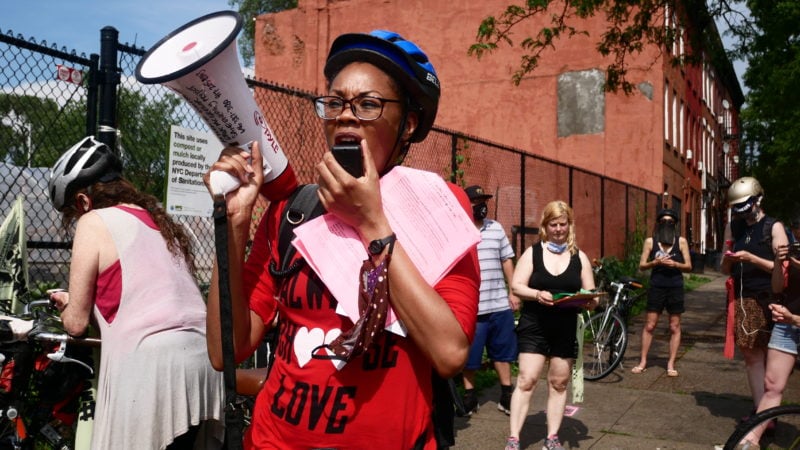On a sweltering June day, a high-spirited group of about 50 activists and local residents gathered on the edge of a park in the Brooklyn neighborhood of Brownsville. Many were wheeling bikes with colorful flags that read “Poison Route” and “Ruta Venenosa,” referring to the streets that have been overturned to make way for a pipeline that is expected to funnel fracked gas through largely low-income, Black and brown communities in North Brooklyn. The plan was to bike along the seven-mile route of the nearly finished pipeline, from Brownsville the Greenpoint—to more clearly visualize and expose this environmental injustice. Threaded through the spokes of one bike, a sliver of cardboard read “Black Lives Matter,” underscoring the connection between this effort and the protests taking place across the city and around the world in the wake of George Floyd’s brutal killing in late May.
The story of the North Brooklyn pipeline, which the utility corporation National Grid opaquely named the Metropolitan Natural Gas Infrastructure Project, is familiar in many ways. Across the country, low-income neighborhoods of color are frequently targeted for fossil fuel infrastructure—to the point where a 2017 report found that, in some states, one in five Black Americans live just half a mile away from an oil or gas facility. It’s one of the many reasons a broad coalition of climate justice activists, community organizations, and local residents is fighting the pipeline’s ongoing construction, which quietly began three years ago. One banner at the protest put it plainly: “Pipelines threaten Black lives.”
Kicking off the protest, Dragonfly, also known as Robin LaVerne Wilson, an artist whose work is anchored in performance, language, ritual, and music, asked protestors to breathe, to acknowledge each other and the stolen Lenape land they were standing upon. Wearing a bike helmet adorned with a flag made of Post-It notes and popsicle sticks that said “Black Lives Matter,” she reminded the assembled of the moment’s urgency. “This is one of the most intersectional protests possible. We’re talking about environmental racism. We’re talking about the misallocation of resources.”
Lee Ziesche, an organizer with Sane Energy Project, a grassroots group dedicated to fighting fossil fuel infrastructure, spoke next. “What we’re fighting for every day right now is our community. National Grid does not have the consent of any of the communities along this route,” said Ziesche, who had fastened to her shorts an orange flag that read #NoNBKPipeline. “So, we’re going to keep fighting in the regulatory spaces to prevent National Grid from raising our bills to pay for this pipeline, but we are also willing to put our bodies in front of the construction if that what it takes,” she declared as the crowd burst into cheers.
Already, activists have been putting their bodies on the line to stop the pipeline. In February, shortly after New York City Mayor Bill De Blasio signed an executive order banning all new fossil fuel infrastructure in the city—an order that did not extend to the North Brooklyn Pipeline—protestors rallied in below-freezing weather and blocked the pipeline’s construction. Later in the month, protestors were arrested for again disrupting construction.
According to National Grid’s website, the pipeline will play a part in modernizing Brooklyn’s natural gas system, making it safer and more reliable. Yet if fracked gas is allowed to flow through the mostly constructed pipeline, there’s always a risk that it could explode. “There are hundreds of thousands of people living in the evacuation zone of this pipeline if something went wrong,” Ziesche told crowd, many of whom live in this radius. According to an analysis by FracTracker Alliance, there are 81 daycare facilities, 55 public schools, eight private schools, three nursing homes, and one medical center in the evacuation zone of the pipeline.
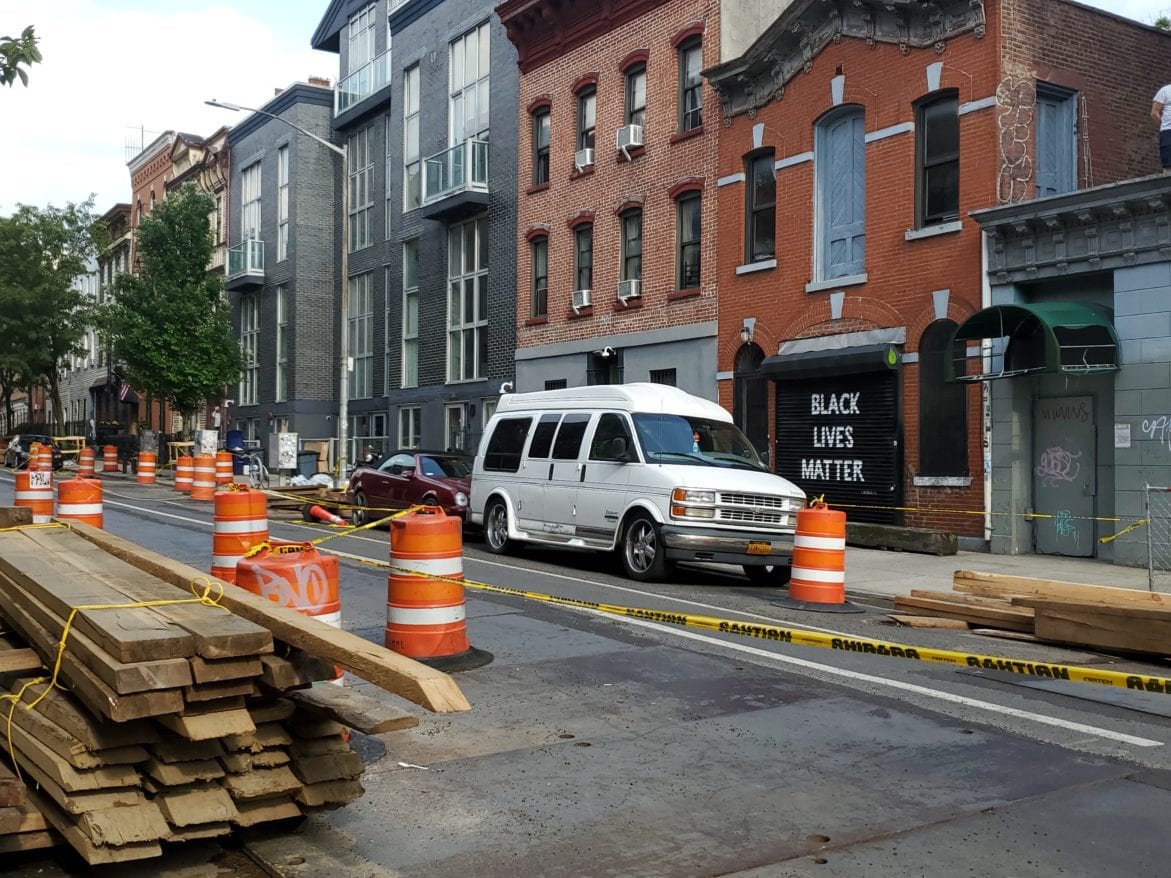
And the very communities the pipeline could harm will be the ones paying for it, for years to come. The utility company is proposing a rate hike on customers’ bills that will partially go to funding the final segment of the pipeline in East Williamsburg and Greenpoint, where it will eventually connect to an expanded liquified natural gas depot. The expected cost of this segment is $185 million, adding to utility bills during a period of mass unemployment. “Nobody should be going into debt for National Grid’s fracked gas pipeline,” Ziesche said, her voice rising.
Then, of course, there’s the harm the pipeline will do to the planet’s already deteriorating climate. Although New York banned the highly extractive process of hydraulic fracking, this did nothing to halt the transportation of fracked gas produced elsewhere into New York state. The North Brooklyn pipeline will bring in fracked gas from Pennsylvania, where there is a known methane leakage problem. The main ingredient in fracked gas, methane is estimated to be 30 times more potent than carbon dioxide as an earth-warming gas. These emissions at the point of extraction, as well as through leaks along the entire pipeline, will now need to be considered under New York’s landmark state law, the Climate Leadership and Community Protection Act (CLCPA), Ziesche told me when we spoke after the protest.
There is already some precedent for screening fossil fuel infrastructure decisions through the CLCPA, which went into effect in January. In May, New York State’s Department of Environmental Conservation denied a water permit for the Williams Northeast Enhancement Supply pipeline, which activists had been fighting for years, partially because the project was found to be inconsistent with the new law’s ambitious mandates.
While a central demand of the protest is for the Public Service Commission to deny National Grid’s funding request for the last stretch of the pipeline, what draws people to the protest is about more than that: It’s also about imagining what could exist in the place of the extractive industry in North Brooklyn. Gabriel Jamison, who grew up in Brownsville and is now a member of the Brooklyn Community Board 16, took up the megaphone next. “We need renewable energy. We need solar for all. We need sustainable development. We need healthy food and we need to be training the next generation in how to take care of this earth,” said Jamison, who leads a program at Nehemiah Economic Development to make solar energy more accessible to Brownsville. “We do not deserve this in our community,” he said, gesturing at the banners behind him decrying the pipeline.
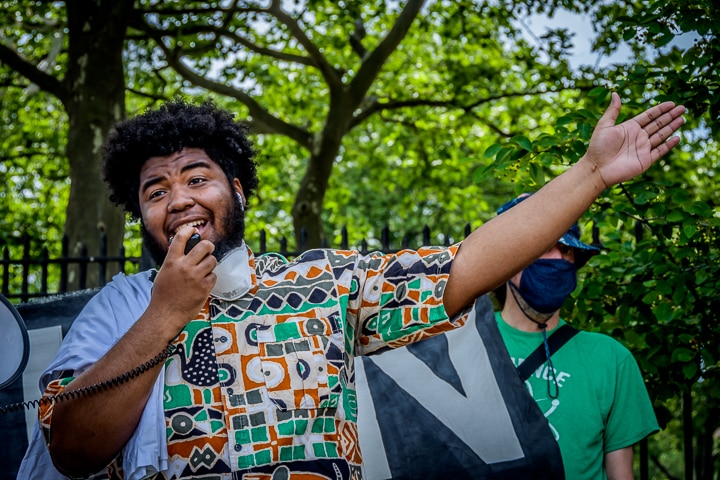
Snacks, hand sanitizer, and masks—the essentials for protesting during a pandemic—were distributed, and we took to our bikes. What started as a slow trickle of cyclists soon became a steady stream, as we shouted in unison, “Hey hey, ho ho, this racist pipeline has got to go.”
As we biked north, we made stops to hear from community members and protestors who opposed the pipeline, while connecting it to broader injustices and visions for the future. At the Powell St. Community Garden, we gathered beneath the shade of a tree to hear Brenda Thompson Duchene, the director of Isabahlia Ladies of Elegance Foundation Inc., talk about how community gardens can feed the local neighborhood. Just outside of the fence of an urban farm, labor and community activist David Galarza Santa reflected on how the pipeline fight connects to the 2012 struggle against a 92-mile Via Verde pipeline that would have cut through mountains and cities in Puerto Rico. In Bushwick, a banner dropped from a third-floor apartment window, “Fuck the pipeline, Fuck the police,” setting the stage for Jorge Arteaga, the director of Hallaback!, to speak about the need for communities to take care of each other instead of relying on the police. Toward the end of the route, Kevin LaCherra, whose family has lived in Greenpoint for over 120 years, described the legacy of dangerous extractive industry in North Brooklyn, including lead-poisoned soil, some of the highest asthma rates in the nation, and the largest recorded oil spill in US history.
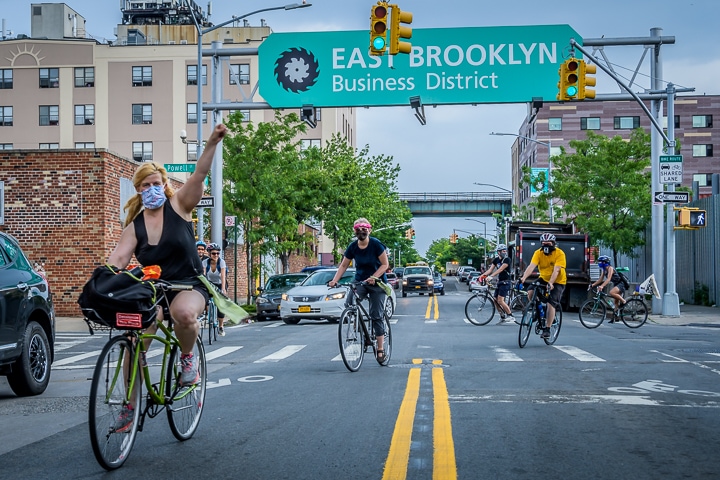
Of course, the Black Lives Matter protests were at the forefront of organizers’ minds. Noel Sanchez is a youth educator at the Sixth Street Community Center whose family has lived in North Brooklyn for decades. “Systemic racism lies deep in the crevices of the land of the not so free,” he told the protesters. “Today we are here fighting against environmental racism, and the climate crisis, and how it plagues our very own Black and brown communities of North Brooklyn.”
Like many companies, National Grid put out a statement in support of Black Lives Matter. Yet the company is still continuing with the construction of the North Brooklyn pipeline, which would put a largely Black and brown community at risk. Protestors say National Grid never informed them about the pipeline, let alone gave them an opportunity to consent to it. In January, at a packed Brooklyn Community Board 1 meeting, National Grid representatives claimed they knocked on doors, but outraged local residents said they never received notice. Later, the community board voted unanimously in opposition to the pipeline.
While the utility company didn’t violate any known regulations, many see a breach of trust in what seemed like intentionally opaque, or absent, communications from the company. “The lack of transparency with this project has been really disturbing,” Jen Chantrtanapichate, a community organizer, climate justice activist, and program director of the Sixth Street Community Center, told me in a phone interview. Chantrtanapichate noticed the construction, right by her laundromat and diner, but didn’t think too much of it at first. “I think we’re very immune to construction in New York City. There’s so much new construction all around, a lot of it is related to gentrification.” When Kim Fraczek, an organizer at Sane Energy Project, told her about it while they were protesting the Cricket Valley Power Plant in late 2019, she was shocked.
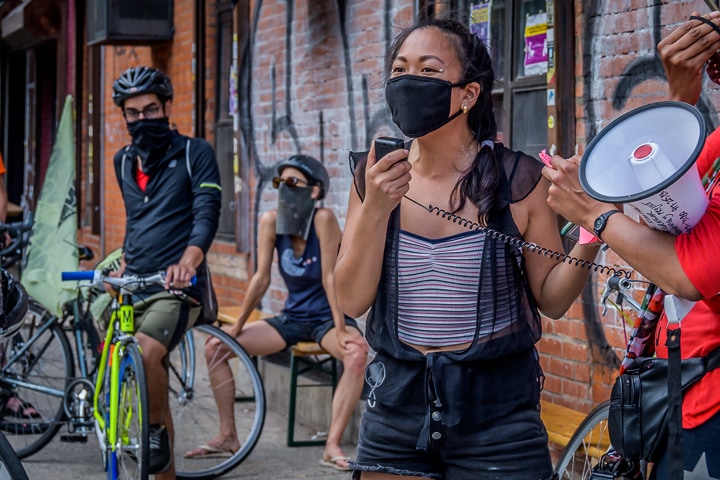
The pipeline first came to the attention of Kim Fraczek and Lee Ziesche through National Grid’s rate case, a procedure held by the Public Service Commission to determine whether a proposed increase in monthly utility bills is justifiable. In October of 2019, just as National Grid broke ground near Fraczek’s home, it became clear that this construction was one of the projects for which the utility corporation requested funding. As party to the rate case, Sane Energy Project has been advocating against the pipeline, along with the rate hike and any infrastructure that would extend the life of fossil fuels.
At a busy intersection in East Williamsburg, Fraczek paused at an active construction site where a segment of pipeline sat exposed. “This is about workers’ rights, too,” she said, explaining that construction workers shouldn’t be there during a pandemic. Construction on the pipeline resumed on May 18, while New York City’s stay-at-home order prohibiting non-essential work, remained in effect. Earlier, Fraczek pointed out the yellow spray-painted lines that marked where the gas pipeline had already been installed. It was easy to overlook, but once you recognize it—and realize it signals incoming fracked gas—it’s hard to see anything but a poisonous route.
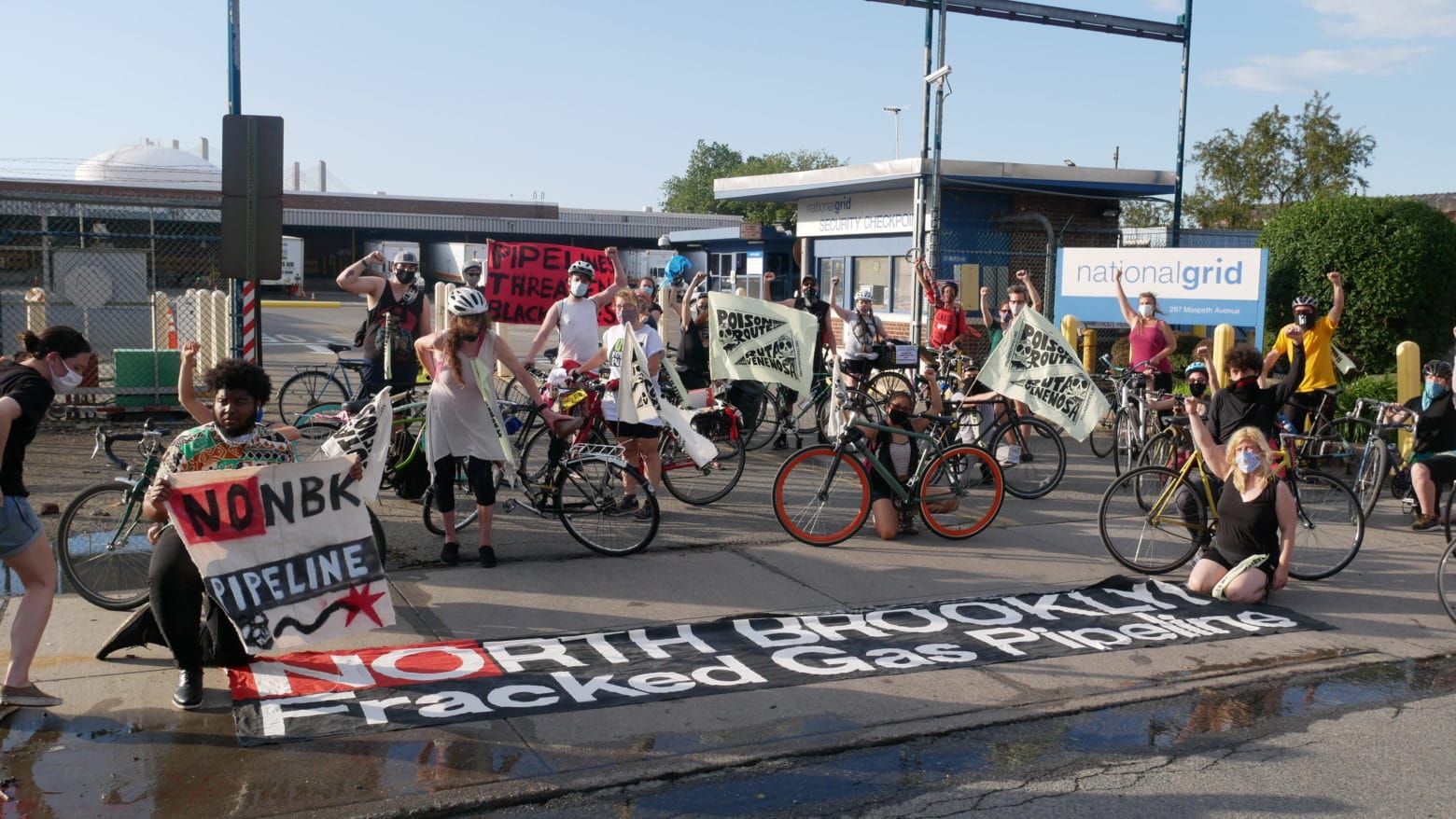
As the sun lowered in the sky, cutting it close to the city-wide curfew, the group of bikers made their way to the industrial part of Greenpoint, and to National Grid’s depot right by Newton Creek. The Greenpoint oil spill, first observed here in 1978, wasn’t a single spill, but rather the toxic accumulation of oil from more than 140 years of spillage—a slow, harmful pooling beneath the ground. Gathered at this site, though, the mood is not one of mourning, but one of possibility. “First let’s just breathe. We’re going to conspire again,” said Dragonfly. “To conspire is to breathe together.”
There’s another possibility for those yellow lines on the pavement: They could come to signal an empty pipeline, one that is never completed or allowed to carry fracked gas, a decision that would signal a break from the legacy of racist extraction. A few days after the protest, Dragonfly texted me to say she’d found a new place for the Black Lives Matter sign she wore in her helmet at the bike protest. It’s now staked into the ground in Bedford-Stuyvesant’s Saratoga Park. “Black liberation is the act of staking a claim to exist,” she said, “in spaces where we have been criminalized and murdered, including public space. Including the addresses we call ‘home.’”
